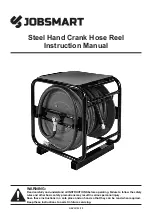
CAUTION:
ENSURE ADEQUATE VENTILATION. DO NOT SPRAY NEAR
NAKED FLAMES.
KEEP AIR BRUSH
PARALLEL TO SURFACE
Fig. 2
Fig. 3
SURFACE
START
MOTION
HERE
PRESS
TRIGGER
HERE
RELEASE
TRIGGER
HERE
FOLLOW
THROUGH
MOTION
KEEP MOTION
STEADY AND SPRAY
NOTE:
To achieve the best results when spraying it is always best to start with the air brush clean and totally
free from old paint deposits, dirt etc. Therefore the air brush should be thoroughly cleaned immediately
after each operation.
4.1. Remove the empty gravity cup, wipe the inside thoroughly, including the lid.
4.2. Fill the cup half full of thinners and re-attach to the air brush.
4.3. Spray onto newspaper, this will clean the needle, fluid cap and air tip. Hold a soft cloth over the fluid cap
and spray again, this will force air and thinners through the air brush and clean the internal moving parts.
Should the air brush become clogged with paint, remove the needle, cap and tip as follows:
4.3.1. Squeeze the two halves of the housing (1 & 2) together to prevent the nozzle seat (6) rotating.
4.3.2. Using the spanner provided unscrew the nozzle and remove the needle.
4.4. Clean the needle, fluid cap and air tip with a small piece of cotton wool dipped in thinners.
4.5. Re-assemble the air brush by reversing the above instruction.
4. CLEANING & MAINTENANCE
THE PROBLEM
Paint Runs.
Grainy Spray.
Paint Splattering.
Curved Stroke.
Paint Spitting.
Restricted Spray.
Bubbles in Paint Jar
Erratic Spray
5. TROUBLESHOOTING
THE CAUSE
Too much paint applied.
Moving air brush too slowly along workpiece.
Not releasing trigger at the end of stroke.
Paint too thick.
Dried paint deposits on tip, needle or regulator.
Needle snapping back into tip.
Air brush arcing too close to object.
Needle snapping back into tip.
Regulator screwed in too tight.
Paint tube in pot clogged.
Regulator open too loose.
Paint tube in pot clogged.
Fluid needle bent or paint deposits on needle.
THE SOLUTION
Hold brush further away from object.
Press trigger lightly.
Move at a constant speed.
Release trigger at end of stroke.
Thin paint.
Clean air brush thoroughly,
(as described above).
Release needle gently.
Keep air brush parallel to the object,
unless curved stroke is desired.
Release needle gently.
Loosen regulator.
Clean as described above.
Tighten regulator.
Clean as described above.
Replace needle or clean as
required.
01284 757500
01284 703534
NOTE:
It is our policy to continually improve products and as such we reserve the right to alter data, specifications and component
parts without prior notice.
IMPORTANT:
No liability is accepted for incorrect use of this equipment.
WARRANTY:
Guarantee is 12 months from purchase date. proof of which will be required for any claim.
INFORMATION:
For a copy of our latest catalogue and promotions, call us on 01284 757525 and leave your full name and address
including your postcode.
Sole UK Distributor, Sealey Group
, Bury St. Edmunds, Suffolk.
Web
www.sealey.co.uk
AB931 - 1 - 200203
AB931 - 1 - 200203
3.6. Holding the air brush about 6 inches from the surface press the trigger. Using short strokes, move the air
brush at a steady rate, parallel to the surface (Fig.2).
3.7. Apply a light coat of paint, let it dry, then apply another coat. Continue with this method until the desired
coverage is reached. DO NOT spray too heavily.
3.8. Once you are satisfied with the results of your test pieces and have made any necessary adjustments
to the air brush, continue with the task to be performed. Best results are achieved with a good
constant motion. Start the motion before pressing the trigger, and follow a through motion after
releasing the trigger (Fig.3).




















